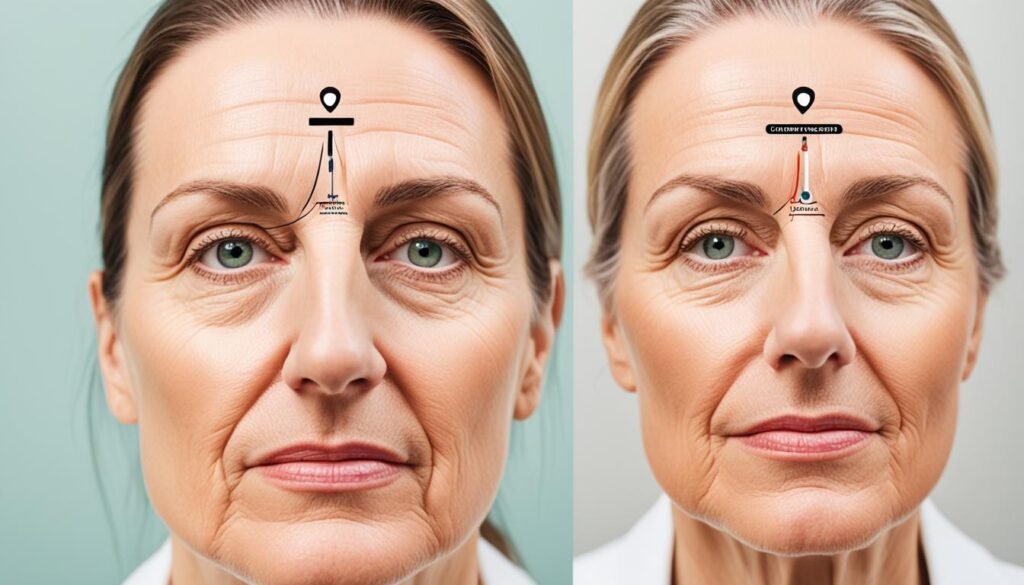If you or someone you know experiences sudden weakness or paralysis on one side of the face, it could be a symptom of Bell’s Palsy. A condition that causes facial muscles to weaken or become paralyzed. It is also known as acute peripheral facial palsy of unknown cause.
The exact cause of Bell’s Palsy is unknown, but experts believe it is related to swelling and inflammation of the facial nerve due to a viral infection. This condition can cause one corner of the mouth to droop, difficulty in closing the affected eye, as well as other symptoms including drooling, pain around the jaw or ear, increased sensitivity to sound, headache, loss of taste, and changes in tear and saliva production.
If you suspect that you or someone you know has Bell’s Palsy, it is important to seek medical attention for proper diagnosis and understanding of the condition. Early identification and understanding of Bell’s Palsy symptoms can help in determining the appropriate course of treatment and management.
Key Takeaways:
- Bell’s Palsy is a condition that causes sudden weakness or paralysis of the facial muscles.
- The exact cause of Bell’s Palsy is unknown, but it is believed to be related to swelling and inflammation of the facial nerve due to a viral infection.
- Bell’s Palsy symptoms include facial drooping, difficulty in making facial expressions, drooling, pain, and changes in tear and saliva production.
- Seeking prompt medical attention is essential for proper diagnosis and appropriate management of Bell’s Palsy.
- Early identification and understanding of Bell’s Palsy symptoms can help in determining the appropriate course of treatment and management.
Table of Contents
ToggleBell’s Palsy Causes
The exact Bell’s Palsy causes is unknown, but it is believed to be triggered by viral infections such as herpes simplex, herpes zoster, respiratory illnesses, and other viral infections. These viruses can cause inflammation and swelling of the facial nerve, resulting in the characteristic paralysis of Bell’s Palsy.
Aside from viral infections, there are several other factors that can increase the risk of developing Bell’s Palsy. These include:
- Pregnancy: Women who are pregnant, especially during the third trimester or in the first week after giving birth, have a higher risk of developing Bell’s Palsy.
- Upper respiratory infections: Infections such as the common cold or flu can increase the likelihood of developing Bell’s Palsy.
- Diabetes: Individuals with diabetes have an increased risk of nerve damage, which can make them more susceptible to Bell’s Palsy.
- High blood pressure: Hypertension is associated with an increased risk of developing Bell’s Palsy.
- Obesity: Being overweight or obese can also contribute to the development of Bell’s Palsy.
It’s important to note that while these factors might increase the risk, not everyone who has them will develop Bell’s Palsy. The condition can still occur without any known risk factors.

Bell’s Palsy Symptoms
When it comes to Bell’s Palsy, recognizing the symptoms is crucial for timely diagnosis and Bell’s Palsy Treatment. The Bell’s Palsy symptoms can manifest suddenly and impact one side of the face. Key symptoms include:
- Rapid onset of weakness or paralysis: The affected muscles on one side of the face may feel weak or completely paralyzed.
- Drooping of the face: One corner of the mouth may droop, giving a lopsided appearance to the face.
- Difficulty making facial expressions: It becomes challenging to control the muscles responsible for facial expressions, such as smiling or frowning.
- Drooling: The inability to control facial muscles can lead to drooling or excessive saliva production.
- Pain around the jaw or ear: Some individuals may experience pain or discomfort in the jaw or ear area on the affected side.
- Increased sensitivity to sound: Everyday sounds may seem louder and more bothersome to individuals with Bell’s Palsy.
- Headache: The condition may be accompanied by a headache, which can vary in intensity.
- Loss of taste: Some individuals may notice a diminished sense of taste on the affected side of the tongue.
- Changes in tear and saliva production: Tear production may be reduced, leading to dry eyes, while saliva production may increase, causing a dry or watery mouth.
- Paralysis on both sides of the face: Although rare, in some cases, Bell’s Palsy can cause paralysis on both sides of the face simultaneously.
If you experience any type of paralysis on one side of your face, it is vital to seek medical attention promptly. While Bell’s Palsy is typically benign, it is essential to rule out the possibility of a stroke, as the symptoms can be similar.

Bell’s Palsy Diagnosis and Treatment
To accurately diagnose Bell’s Palsy, a physical examination is typically conducted by a healthcare professional to assess the extent of facial weakness and determine the absence of other potential causes. While there is no specific lab test for Bell’s Palsy, the examination focuses on ruling out conditions that may mimic its symptoms.
If Bell’s Palsy is confirmed, appropriate treatment options can be considered. The primary goal of treatment is to reduce inflammation and promote the recovery of the facial nerve. Below are some commonly used treatments:
Corticosteroid Medications
Corticosteroids, such as prednisone, are commonly prescribed to reduce inflammation and potentially speed up the recovery process. These medications work by suppressing the immune response that may be causing the facial nerve inflammation. A typical course of corticosteroids may last for a few weeks.
Antiviral Drugs
While Bell’s Palsy is not directly caused by a viral infection, antiviral medications, such as acyclovir, may be prescribed in some cases. These drugs aim to target any underlying viral infections that could potentially contribute to the facial nerve inflammation.
Over-the-Counter Pain Medications
Over-the-counter pain medications, such as acetaminophen or ibuprofen, may be recommended to help manage any pain or discomfort associated with Bell’s Palsy.
Eye Drops
Eye drops may be prescribed to keep the affected eye lubricated and prevent dryness. Bell’s Palsy can sometimes lead to difficulty closing the eye, which can result in dryness and potential complications. Eye drops can help alleviate these symptoms and protect the eye.
Surgery (Last Resort)
In rare and severe cases of Bell’s Palsy where the facial nerve is irreparably damaged, surgery may be considered as a last resort. Surgical interventions, such as nerve grafting or muscle transfer, aim to restore facial movement by redirecting nerves or muscles to compensate for the affected facial muscles.
Physical Therapy Exercises
Physical therapy exercises play a crucial role in the treatment of Bell’s Palsy. These exercises help strengthen facial muscles, improve coordination, and enhance facial movement. A physical therapist can guide individuals through specific exercises tailored to their needs and monitor progress throughout the recovery process.
It is important to note that the choice of treatment may vary depending on the individual’s specific condition and the recommendations of their healthcare provider. It is advisable to consult with a medical professional for a comprehensive evaluation and personalized treatment plan.

Complications of Bell’s Palsy
Bell’s Palsy is typically a temporary condition that resolves within a month for most individuals. However, in severe cases where the facial muscles are completely paralyzed, complications may arise that can affect various aspects of daily life.
- Irreversible damage to the facial nerve: In some instances, Bell’s Palsy can result in permanent damage to the facial nerve, leading to long-term weakness or paralysis of the facial muscles. This can impact facial expression, speech, eating, and other functions.
- Irregular regrowth of nerve fibers: As the facial nerve heals, there is a possibility of irregular regrowth of nerve fibers, which can result in involuntary muscle contractions. This can lead to facial twitching or spasms, making it difficult to control facial movements.
- Partial or complete blindness of the eye: One of the complications of Bell’s Palsy that can occur is excessive dryness and scratching of the cornea due to inadequate tear production. This can result in partial or complete blindness of the affected eye. Proper eye care, including the use of lubricating eye drops, is crucial to prevent this complication.
It is important to note that these complications are relatively rare, and most individuals with Bell’s Palsy experience a full recovery without significant long-term effects. However, it is essential to seek medical attention and follow recommended treatment strategies to minimize the risk of complications and promote optimal healing.
Risk Factors for Bell’s Palsy
Bell’s Palsy is a condition that can affect anyone, but certain risk factors can increase your chances of developing it. Understanding these risk factors can help you take necessary precautions and seek timely medical attention if needed.
1. Pregnancy and Postpartum Period
Pregnant women, especially those in their third trimester or the first week after giving birth, have an increased risk of developing Bell’s Palsy. Hormonal changes and a weaker immune system during pregnancy may contribute to this vulnerability.
2. Upper Respiratory Infections
Having an upper respiratory infection, such as the common cold or flu, increases the risk of developing Bell’s Palsy. The infection can cause inflammation and swelling around the facial nerve, leading to the condition.
3. Diabetes, High Blood Pressure, and Obesity
Individuals with pre-existing conditions like diabetes, high blood pressure, and obesity have a higher likelihood of experiencing Bell’s Palsy. These conditions can weaken the immune system and affect nerve function, making them more susceptible to developing facial paralysis.
4. Family History
While recurrent attacks of Bell’s Palsy are rare, some cases may have a familial component. Having a family history of the condition suggests a genetic predisposition that increases the risk of developing Bell’s Palsy.
Bell’s Palsy in Comparison to Stroke
Bell’s Palsy and stroke can cause similar symptoms such as facial paralysis and difficulty closing the eye. However, there are significant differences between the two. Bell’s Palsy is not caused by a stroke but can cause similar symptoms. Additional symptoms that suggest Bell’s Palsy rather than a stroke include drooling, pain around the jaw or ear, increased sensitivity to sound, headache, and changes in tear and saliva production. If you experience sudden facial weakness, it is important to seek medical attention to rule out a stroke.

Bell’s Palsy Recovery and Prognosis
Most cases of Bell’s Palsy improve within a few weeks or months without treatment. The recovery time can vary depending on the severity of the nerve damage. Mild cases may show improvement within 2-3 weeks, while more severe cases may take 3-6 months. In rare cases, symptoms may persist or be permanent. Physical therapy exercises, medication, and surgical interventions may be used to aid in the recovery process and improve long-term outcomes.

If you have been diagnosed with Bell’s Palsy, it is important to understand the potential for recovery and the prognosis. While the condition can be concerning, it is important to remain hopeful, as many individuals experience significant improvement over time.
The recovery process for Bell’s Palsy is highly individualized and can depend on various factors, including the severity of the facial paralysis and the overall health of the individual. Mild cases of Bell’s Palsy may recover fully within a relatively short period of time, typically within a few weeks.
However, more severe cases of Bell’s Palsy may require a longer recovery period. It is not uncommon for individuals with severe Bell’s Palsy to experience improvement over the course of several months. In some cases, recovery may be incomplete, and some residual facial weakness or other symptoms may persist.
Physical therapy exercises are often recommended as part of the recovery process for Bell’s Palsy. These exercises are designed to help strengthen the facial muscles and improve coordination, allowing for more controlled and natural facial movements.
Additionally, medication may be prescribed to reduce inflammation and promote healing. In some cases, surgical interventions may be considered as a last resort to address any residual facial weakness or other complications.
Factors Affecting Bell’s Palsy Recovery
Various factors can influence the recovery process and the overall prognosis for individuals with Bell’s Palsy:
- The severity of the facial paralysis
- The age and overall health of the individual
- Compliance with recommended treatment, including physical therapy exercises and medication
- Any underlying medical conditions or complications that may contribute to the recovery process
- The individual’s lifestyle and stress levels
It is important to work closely with healthcare professionals throughout the recovery process to ensure the best possible outcomes. Regular follow-up appointments and open communication with your healthcare team can help address any concerns or challenges that may arise.
| Severity of Bell’s Palsy | Recovery Time |
|---|---|
| Mild | 2-3 weeks |
| Moderate | 1-3 months |
| Severe | 3-6 months or longer |
Remember, every individual and every case of Bell’s Palsy is unique. While the prognosis for Bell’s Palsy is generally positive, it is important to consult with your healthcare provider for personalized guidance and to address any specific concerns about your recovery.
Conclusion
Bell’s Palsy is a temporary condition that results in weakness or paralysis of the facial muscles. It is often related to viral infections and can cause various symptoms, including facial drooping, difficulty in making facial expressions, drooling, pain, and changes in tear and saliva production. While most cases of Bell’s Palsy recover without complications, severe cases may lead to long-term effects.
Prompt medical attention is crucial for the diagnosis and appropriate management of Bell’s Palsy. Treatment options typically involve medications to reduce inflammation, antiviral drugs, pain relievers, and eye drops to maintain eye moisture. In some cases, physical therapy exercises or surgical interventions may be necessary to aid in recovery.
If you experience any symptoms of Bell’s Palsy, it is important to seek medical attention to receive an accurate diagnosis and appropriate treatment. Early intervention can help expedite the recovery process and improve outcomes. Remember to consult a healthcare professional for personalized advice and guidance.
FAQ
What is Bell’s Palsy?
Bell’s Palsy is a condition that causes sudden weakness in the muscles on one side of the face. It is also known as acute peripheral facial palsy of unknown cause.
What are the main symptoms of Bell’s Palsy?
The main symptom is facial paralysis, which can cause one corner of the mouth to droop and difficulty in closing the affected eye. Other symptoms include drooling, pain around the jaw or ear, increased sensitivity to sound, headache, loss of taste, and changes in tear and saliva production.
What are the causes of Bell’s Palsy?
The exact cause of Bell’s Palsy is unknown, but it is believed to be triggered by viral infections such as herpes simplex, herpes zoster, respiratory illnesses, and other viral infections. Other factors that increase the risk of developing Bell’s Palsy include pregnancy, upper respiratory infections, diabetes, high blood pressure, and obesity.
How is Bell’s Palsy diagnosed and treated?
Diagnosis of Bell’s Palsy is usually based on physical examination and ruling out other possible causes of facial weakness. Treatment options include corticosteroid medications to reduce inflammation, antiviral drugs, over-the-counter pain medications, eye drops to keep the affected eye moist, and surgery as a last resort.
What are the complications of Bell’s Palsy?
Most cases of Bell’s Palsy resolve within a month with no complications. However, complications can occur in more severe cases where the face is completely paralyzed. These complications may include irreversible damage to the facial nerve, irregular regrowth of nerve fibers leading to involuntary muscle contractions, and partial or complete blindness of the eye due to excessive dryness and scratching of the cornea.
What are the risk factors for Bell’s Palsy?
The risk of developing Bell’s Palsy is increased in pregnant women, especially during the third trimester or in the first week after giving birth. Other risk factors include upper respiratory infections, diabetes, high blood pressure, and obesity. Recurrent attacks of Bell’s Palsy are rare but may have a family history component, suggesting a genetic predisposition.
How does Bell’s Palsy compare to a stroke?
Bell’s Palsy and stroke can cause similar symptoms such as facial paralysis and difficulty closing the eye. However, there are significant differences between the two. Bell’s Palsy is not caused by a stroke but can cause similar symptoms. Additional symptoms that suggest Bell’s Palsy rather than a stroke include drooling, pain around the jaw or ear, increased sensitivity to sound, headache, and changes in tear and saliva production.
What is the recovery time for Bell’s Palsy?
Most cases of Bell’s Palsy improve within a few weeks or months without treatment. The recovery time can vary depending on the severity of the nerve damage. Mild cases may show improvement within 2-3 weeks, while more severe cases may take 3-6 months. In rare cases, symptoms may persist or be permanent. Physical therapy exercises, medication, and surgical interventions may be used to aid in the recovery process and improve long-term outcomes.
What should I do if I experience symptoms of Bell’s Palsy?
If you experience any symptoms of Bell’s Palsy, it is important to seek medical attention for diagnosis and appropriate management.
About The Author

This article is medically reviewed by Dr. Chandril Chugh, Board-Certified Neurologist, providing expert insights and reliable health information.
Dr. Chandril Chugh is a U.S.-trained neurologist with over a decade of experience. Known for his compassionate care, he specializes in treating neurological conditions such as migraines, epilepsy, and Parkinson’s disease. Dr. Chugh is highly regarded for his patient-centered approach and dedication to providing personalized care.
→ Book a consultation to discover which remedies suit your needs best.




